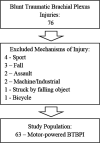Blunt traumatic brachial plexus injuries in a northern rural US setting: increased likelihood in unshielded motor-powered crashes
- PMID: 33305005
- PMCID: PMC7692983
- DOI: 10.1136/tsaco-2020-000558
Blunt traumatic brachial plexus injuries in a northern rural US setting: increased likelihood in unshielded motor-powered crashes
Abstract
Background: Blunt traumatic brachial plexus injuries (BTBPI) are severe peripheral nerve injuries which present in a small portion of trauma patients but can result in long-term neurological disability and severe chronic pain.
Objective: The goal of this study was to describe the epidemiology of BTBPI in a northern rural setting caused by motor-powered collisions, and to determine the relative risk of these injuries in shielded (cars, trucks, vans, and so on) and unshielded vehicles (snowmobiles, all-terrain vehicles and motorcycles).
Methods: This retrospective study describes the epidemiology of BTBPI caused by motor-powered collisions and treated at two level II trauma centers in northeast Minnesota and determines the relative risk of these injuries in shielded (cars, trucks, vans, and so on) and unshielded vehicles (snowmobiles, all-terrain vehicles and motorcycles). We hypothesized unshielded motor vehicle crashes in rural areas are at an increased risk of incurring BTBPI.
Results: Out of all injuries resulting from motor-powered collisions in a 20-year period (9951), BTBPIs were found in 63 trauma patients, a prevalence of 0.6%. The rate of BTBPI involving unshielded vehicles (1.0%) was significantly higher than those involving a shielded vehicle (0.4%) and primarily occurred in rural areas (70%).
Conclusions: Unshielded vehicle crashes, particularly snowmobiles, have the highest risk for BTBPI in our rural region. The overall incidence of these injuries appears to be declining.
Level of evidence: Level III.
Keywords: accidental injuries; accidents; epidemiology; neck injuries; traffic.
© Author(s) (or their employer(s)) 2020. Re-use permitted under CC BY-NC. No commercial re-use. See rights and permissions. Published by BMJ.
Conflict of interest statement
Competing interests: None declared.
Figures


Similar articles
-
Traumatic peripheral nerve injuries in children: epidemiology and socioeconomics.J Neurosurg Pediatr. 2014 Dec;14(6):688-94. doi: 10.3171/2014.8.PEDS14112. Epub 2014 Oct 10. J Neurosurg Pediatr. 2014. PMID: 25303155
-
Epidemiologic characteristics of drivers, vehicles, pedestrians and road environments involved in road traffic injuries in rural Thailand.Southeast Asian J Trop Med Public Health. 1994 Mar;25(1):37-44. Southeast Asian J Trop Med Public Health. 1994. PMID: 7825023
-
All-terrain vehicle and bicycle crashes in children: epidemiology and comparison of injury severity.J Pediatr Surg. 2002 Mar;37(3):375-80. doi: 10.1053/jpsu.2002.30826. J Pediatr Surg. 2002. PMID: 11877651
-
Comparison of Urban Off-Road Vehicle and Motorcycle Injuries at a Level 1 Trauma Center.J Surg Res. 2020 Jan;245:373-376. doi: 10.1016/j.jss.2019.07.069. Epub 2019 Aug 16. J Surg Res. 2020. PMID: 31425878
-
Cervical spine injuries in children: a review of 103 patients treated consecutively at a level 1 pediatric trauma center.J Pediatr Surg. 2001 Aug;36(8):1107-14. doi: 10.1053/jpsu.2001.25665. J Pediatr Surg. 2001. PMID: 11479837 Review.
Cited by
-
Traumatic Brachial Plexus Injury in Indonesia: An Experience from a Developing Country.J Reconstr Microsurg. 2022 Sep;38(7):511-523. doi: 10.1055/s-0041-1735507. Epub 2021 Sep 1. J Reconstr Microsurg. 2022. PMID: 34470060 Free PMC article.
-
Degenerated nerve grafts provide similar quality and outcome in reconstructing critical nerve defects as compared to fresh nerve grafts.Front Cell Dev Biol. 2025 Jun 3;13:1568935. doi: 10.3389/fcell.2025.1568935. eCollection 2025. Front Cell Dev Biol. 2025. PMID: 40530330 Free PMC article.
References
-
- Kim DH, Murovic JA, Tiel RL, et al. . Mechanisms of injury in operative brachial plexus lesions. Neurosurgical Focus 2007;16:1–8. - PubMed
LinkOut - more resources
Full Text Sources
Research Materials
